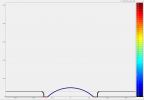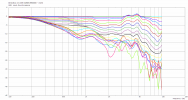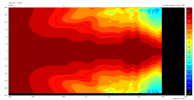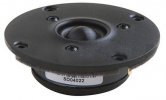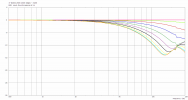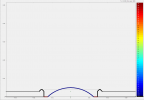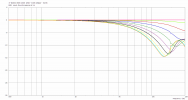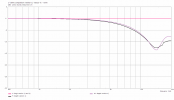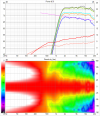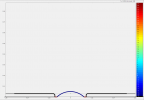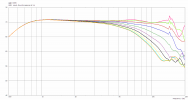ctrl
Major Contributor
Have you ever wondered why the tweeter front plate design is somehow the same and yet different and if these small differences matter at all? Some tweeter front plate are just flat, some have something like tiny little wave-guides or "lenses" integrated,...




I would like to try, to show here with a few simple simulations, what certain changes of the tweeter front plate cause. For this purpose we simulate an ideal 1'' tweeter with about 700Hz resonant frequency fs.
1) Flat front plate
Let's start with the tweeter dome on an infinite baffle. So the tweeter front plate is simply a flat plate.
First the sketch (lateral cutaway drawing of the tweeter dome), then the frequency responses from 0° to 80° (in 10° steps) on infinite baffle (IB) of the dome on a flat front plate and then those normalized to on-axis frequency response:
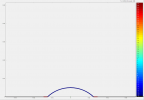
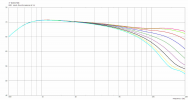

2) Front plate with 3mm step
Next we introduce a 3mm high step (I use the term "step" because it looks like a step in the lateral cutaway drawing of the tweeter dome), one could also say the tweeter has 3mm off-set/recess to the front plate. It is a tiny wave-guide which on-axis contributes to an increase of the SPL of the high frequencies and at the same time makes the radiation less wide.



3) Front plate with 2mm + 1mm steps
Instead of just a big 3mm step, we round the corner a bit. The diameter of the tiny WG remains unchanged.
The radiation becomes minimally narrower, but more uniform above 15kHz.



Something like this is what most tweeters have.
4) Front plate with 2mm + 1mm + 2mm steps
Let's add another step, creating a small wave-guide with 40mm diameter. In the 2-9kHz the on-axis SPL has increased. The radiation becomes a bit narrower.

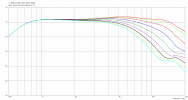
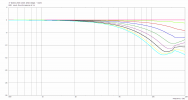
5) Front plate with 2mm + 1mm + 2mm + 3mm steps
The next step with a height of 3mm and a diameter of 70mm provides a wave-guide that most would recognize as such.
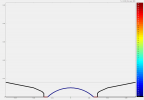


If we now compare the normalized frequency responses of the tweeter with flat front plate with our 70mm WG, for example, at 80° radiation angle the frequency responses at 4kHz are offset by 2.5dB SPL.

The less wide dispersion in the frequency range 2-4kHz usually makes the transition to the woofer more even. However, there are other effects such as edge diffraction that are not discussed here.
6) Front plate with 2mm + 1mm + 2mm + 3mm steps and reflector
If you now want to straighten the on-axis frequency response up to almost 20kHz, you can add a reflector at the expense of radiation - this would look like a washer when viewed from above.



If we now compare the frequency responses (deg0-80 in 10° steps) of the tweeter with flat front plate and the tweeter with the 70mm wave-guide with just 8mm height and reflector on IB, the differences are dramatic (same color, same angle):

To see the impact of each change in direct comparison, here is the FR as a series:
1) Flat front plate
2) Front plate with 3mm step
3) Front plate with 2mm + 1mm steps
4) Front plate with 2mm + 1mm + 2mm steps
5) Front plate with 2mm + 1mm + 2mm + 3mm steps
6) Front plate with 2mm + 1mm + 2mm + 3mm steps and reflector






7) Front plate with "small lip" around the tweeter dome
See post#12 for more details.
8) Tweeter flush mounted but with gap around face plate?
See post#19 for more details.
I would like to try, to show here with a few simple simulations, what certain changes of the tweeter front plate cause. For this purpose we simulate an ideal 1'' tweeter with about 700Hz resonant frequency fs.
1) Flat front plate
Let's start with the tweeter dome on an infinite baffle. So the tweeter front plate is simply a flat plate.
First the sketch (lateral cutaway drawing of the tweeter dome), then the frequency responses from 0° to 80° (in 10° steps) on infinite baffle (IB) of the dome on a flat front plate and then those normalized to on-axis frequency response:



2) Front plate with 3mm step
Next we introduce a 3mm high step (I use the term "step" because it looks like a step in the lateral cutaway drawing of the tweeter dome), one could also say the tweeter has 3mm off-set/recess to the front plate. It is a tiny wave-guide which on-axis contributes to an increase of the SPL of the high frequencies and at the same time makes the radiation less wide.



3) Front plate with 2mm + 1mm steps
Instead of just a big 3mm step, we round the corner a bit. The diameter of the tiny WG remains unchanged.
The radiation becomes minimally narrower, but more uniform above 15kHz.



Something like this is what most tweeters have.
4) Front plate with 2mm + 1mm + 2mm steps
Let's add another step, creating a small wave-guide with 40mm diameter. In the 2-9kHz the on-axis SPL has increased. The radiation becomes a bit narrower.



5) Front plate with 2mm + 1mm + 2mm + 3mm steps
The next step with a height of 3mm and a diameter of 70mm provides a wave-guide that most would recognize as such.



If we now compare the normalized frequency responses of the tweeter with flat front plate with our 70mm WG, for example, at 80° radiation angle the frequency responses at 4kHz are offset by 2.5dB SPL.

The less wide dispersion in the frequency range 2-4kHz usually makes the transition to the woofer more even. However, there are other effects such as edge diffraction that are not discussed here.
6) Front plate with 2mm + 1mm + 2mm + 3mm steps and reflector
If you now want to straighten the on-axis frequency response up to almost 20kHz, you can add a reflector at the expense of radiation - this would look like a washer when viewed from above.



If we now compare the frequency responses (deg0-80 in 10° steps) of the tweeter with flat front plate and the tweeter with the 70mm wave-guide with just 8mm height and reflector on IB, the differences are dramatic (same color, same angle):

To see the impact of each change in direct comparison, here is the FR as a series:
1) Flat front plate
2) Front plate with 3mm step
3) Front plate with 2mm + 1mm steps
4) Front plate with 2mm + 1mm + 2mm steps
5) Front plate with 2mm + 1mm + 2mm + 3mm steps
6) Front plate with 2mm + 1mm + 2mm + 3mm steps and reflector






7) Front plate with "small lip" around the tweeter dome
See post#12 for more details.
8) Tweeter flush mounted but with gap around face plate?
See post#19 for more details.
Last edited:
